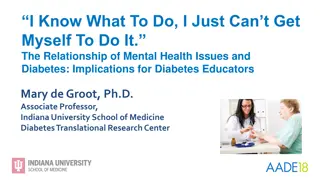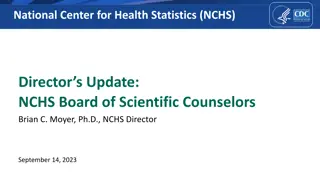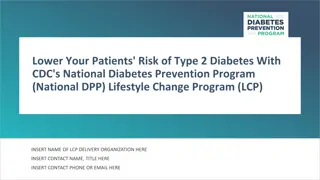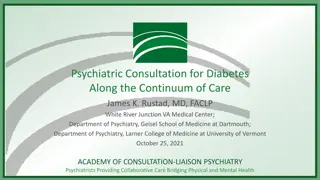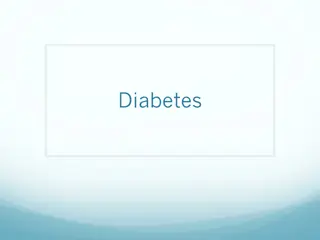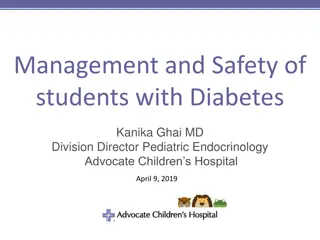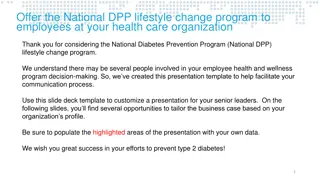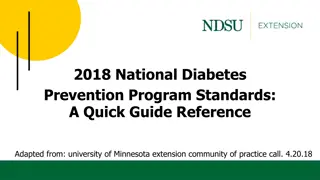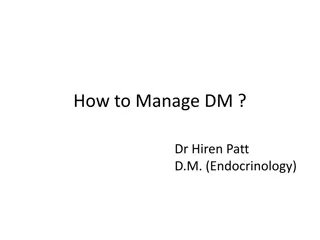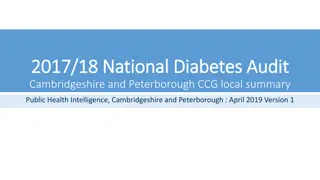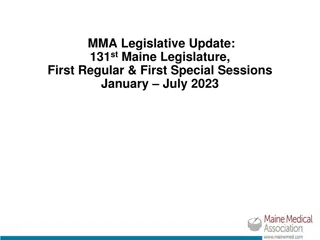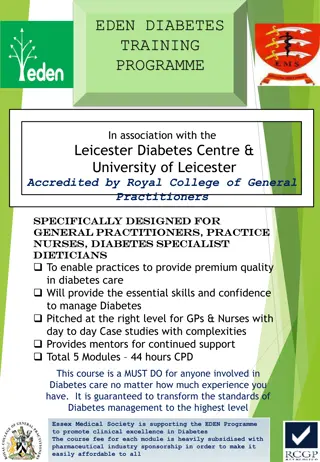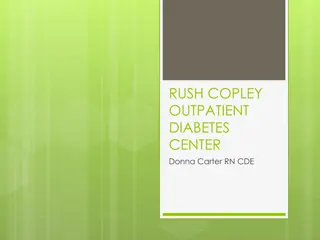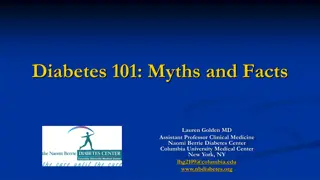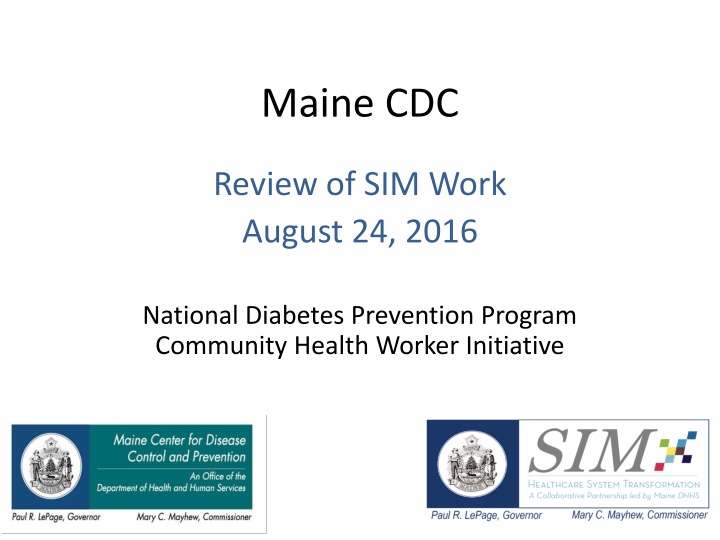
Maine CDC Review of National Diabetes Prevention Program
The Maine CDC conducted a review of the National Diabetes Prevention Program (NDPP) in August 2016. The program aims to prevent or delay the onset of Type 2 diabetes by integrating lifestyle changes for individuals with prediabetes or at high risk. The NDPP has shown a 58% reduction in diabetes risk through modest lifestyle modifications and structured coaching. The CDC grant supports the integration and screening for prediabetes, with measurable outcomes and goals set for implementation by September 2016.
Download Presentation

Please find below an Image/Link to download the presentation.
The content on the website is provided AS IS for your information and personal use only. It may not be sold, licensed, or shared on other websites without obtaining consent from the author. If you encounter any issues during the download, it is possible that the publisher has removed the file from their server.
You are allowed to download the files provided on this website for personal or commercial use, subject to the condition that they are used lawfully. All files are the property of their respective owners.
The content on the website is provided AS IS for your information and personal use only. It may not be sold, licensed, or shared on other websites without obtaining consent from the author.
E N D
Presentation Transcript
Maine CDC Review of SIM Work August 24, 2016 National Diabetes Prevention Program Community Health Worker Initiative
Hypothesis: National Diabetes Prevention Program If the NDPP is integrated into population health management strategies in Maine, we can prevent or delay the progression/onset of Type 2 diabetes for those with prediabetes or at high risk for diabetes. For those who progress to a diabetes diagnosis, they consume 2.3 times more health care dollars. Conclusion: As of July 2016 1,104 program eligible people in Maine have participated in the NDPP and are no longer at risk for Type 2 Diabetes. Further integration and acknowledgement of prediabetes and how to screen for it in clinical/non-clinical settings will continue under U.S. CDC Grant (DP13-1305). U.S. CDC Diabetes Risk Test (www.rethinkdiabetes.org) U.S. CDC Recognized Lifestyle Change Program a.k.a. NDPP
National Diabetes Prevention Program NDPP is based on a research study that demonstrated: Adults at high risk for type 2 diabetes can prevent or delay the disease by 58% (71% if over age 60) by making modest lifestyle changes through a structured program. Lifestyle coaches work with a group to help them reduce their risk of developing type 2 diabetes by: Losing weight through healthy eating Being more physically active Learning to identify and address barriers to healthy eating and physical activity Even after ten years, those who participated had a 34% lower rate of type 2 diabetes. DPP study, NEJM; Feb. 2002
SIM Objective: Implementation of the National Diabetes Prevention Program By September 30, 2016, there will be: At least 20 nationally accredited NDPP provider sites with written data sharing/fidelity agreements At least 80 trained/certified NDPP lifestyle coaches At least 600 eligible adults will have completed the program with fidelity Program fidelity = complete minimum of 9 sessions in first six months and minimum of 4 in second six months
Benefits Outcomes to Date Based on SST Pre-SIM 9 NDPP US CDC recognized provider sites As of August 2016 17 NDPP US CDC recognized provider sites (this is down from 20) 11 additional sites since SIM 42 trained and deployed lifestyle coaches 151 trained and deployed lifestyle coaches 109 additional since SIM 2 more trainings are scheduled for September 2016 104 participants completed with program fidelity 1,104 participants completed with program fidelity 1,000 additional since SIM
Benefits One Maine health plan (State of Maine) has added NDPP coverage to their health plan design. One commercial health plan (Harvard Pilgrim) has begun researching NDPP to identify a way to incorporate coverage of this service into health plan offerings in Maine. Claims/cost analysis for pre-diabetes and diabetes related to MaineCare members is underway to estimate the cost/benefit of adding NDPP for MaineCare beneficiaries to be completed by March 2017. Promoted NDPP as an effective way to manage population health in payment structures for payers, ACOs and other value based purchasing strategies to 20 health care organizations in Maine. CMS has announced intent and proposed provisions for NDPP coverage starting January 2017. As of today 17 out of 20 organizations in Maine are eligible to begin tracking/billing. Payment for eligible beneficiaries starts January 2018. Maintaining U.S. CDC DPRP Pending/Full Recognition impacts eligibility for billing.
Future Recommended Changes/Lessons Learned Directly reached out to Commercial Payers from the beginning of the project. SIM funds to support a NDPP representative to attend and drive the agenda on NDPP throughout the entire SIM project scope in all committees. Identify and advise on Quality Measures for Population Health strategies that target people at high risk for Type 2 Diabetes; recommended protocol for use of evidence-based lifestyle change programs (NDPP).
Sustainability Recommendations NDPP Master Trainer Select business plans available to be shared with any organizations in Maine. Maine NDPP Data Dashboard; Build a referral module for securely transmitting participant session data to PCPs for documentation/billing. Prediabetes standard of care diagnosis/care planning that uses and tracks NDPP participation/completion. CPT 0403T (NDPP participation tracking code introduced January 2016) NDPP provision for coverage for all payers in Maine. Maine CDC able to provide Technical Support for any Maine payer on health plan design before January 2018.
Other External Support for people at high risk for/with chronic diseases. Better use of community-based organizations and help health systems understand how to contract for Population Health and Self- Management Support through ACOs/VBID. Work with Payers to establish provision and performance-based coverage for people at risk for chronic diseases who are well managed or have moved themselves outside of risk. Prediabetes/Diabetes, Hypertension, Lipids
Next Steps Post SIM Continue technical assistance/support to NDPP sites. NDPP Data Dashboard for real time reporting by lifestyle coaches. Technical Assistance to organizations offering NDPP Master Trainer Select and/or NDPP Lifestyle coach trainings. Support use of guidelines/recommendations in the delivery system and health plan design through employers/payers under DP13-1305 Prevention and Control Grant from U.S. CDC through July 2018. Continue http://rethinkdiabetes.org/ as the State of Maine information portal on NDPP Referral and Upcoming Classes. Continue to grow and support the integration of NDPP into Maine s health care delivery system through DP13-1305 Prevention and Control Grant from U.S. CDC through July 2018. Policy/protocol in both clinical/non-clinical settings supporting populations at high risk for Type 2 Diabetes. Lifestyle Coach Network 151 and growing. Maine NDPP Annual Meeting (May 12th2017).
Hypothesis: Community Health Worker Initiative If CHWs are recognized as valued members of the health care system in Maine, they can support improved health outcomes, appropriate utilization of health care services, and increased cost savings related to chronic disease support, cancer screening, and high risk or high consumers of health care services. Conclusion: Achieved increased recognition of CHWs as a potential member of workforce. Pilot sites provided Maine-specific examples.
Community Health Workers Institute for Clinical and Economic Review report summarized results of studies related to CHWs 2013 Contributions of CHWS: Improving health outcomes. Supporting appropriate utilization of health care services. Increased cost savings specific to: Chronic disease support Cancer screening High risk or high consumers of health care services Majority of the 14 studies showed net cost savings over 6 months to 2 years relative to control groups. Institute for Clinical Effectiveness and Review: http://cepac.icer-review.org/?page_id=1066
CHWI Hypothesis Conclusion Formal Recognition CHWI achieved formal recognition of CHWs: DCW Registry to go live June, 2017 Voluntary Components - CHWs may register for training, education and compliance purposes Standardized components set the path for payers to pursue payment models or reimbursement for CHW services
CHWI Hypothesis Conclusion- Recognition from System CHWI Evaluation examined factors that contributed to successful integration of CHWs, two key observations - Clinical provider familiarity and desire to integrate CHWs was observed as growing. Grantees reported that providers appreciated the pilot intervention. I feel [leadership to sustain CHW interventions] is in place. It s very easy to communicate. Staff and providers huddle each morning. In addition, we use the EMR. It s very easy to access the providers with questions and to send notes. It s huge. If I didn t work directly with providers that would be a huge challenge. CHW.
CHWI Hypothesis Conclusion - Provide Models that can be Replicated CHWI effectiveness- Pilot Level - Individual performance metrics tied to intervention and population of focus (i.e. cancer screenings, chronic disease support and promoting appropriate utilization to high risk consumers). Capacity-Building-Level Promote growing workforce in order to spread the model with a focus on long-term sustainability.
Benefits SST Measures to Date 5.5 FTE CHWs hired by 4 Pilot Projects (9 individuals). Referral Mechanisms or MOAs at all 4 Pilot Projects: MeGeneral- Referral Mechanism with 4 affiliated PC Practices Portland Public Health- MOA with primary partner (MaineHealth) DFD Russell- 2 MOAs with hospital and BCCP AAAs- 5 MOAs (hospital, FQHC, home care, EIM, behavioral health) CHW process divided into clients and encounters: 1726 total clients have been engaged with a CHW 223 intensive clients (i.e. longer engagement/more time & attention) 4908 Encounters completed
Benefits Workforce Workforce Expansion 37 CHWs and 19 supervisors completed core training under Maine SIM (November 2014/October 2015). Training in 2015 integrated draft core competencies. Workforce model fills an emerging need by supporting clinicians practicing at top of license. Focus on Population Health - Maine disparities, chronic conditions. Involvement of CHWs in Capacity/Infrastructure Work of the Stakeholder Group. Final SIM training will focus on CHW Trainers (September).
Benefits CHWPP Contribution to Understanding of CHW Model Table 6. Performance measures results, target met or unmet, by the end of Quarter 6 reporting for each pilot project Spectrum Generations/Seniors Plus (105 enrolled) (825 enrolled) Global Referrals 95% (100/105) of clients assessed for need for referral who received at least one referral [Met: 90%] 96% (462/484) of all referrals that were successful linked [Met: 75%] 67% (308/462) of all referrals that were successfully completed [Met: 50%] Medication Review 79% (77/97) of clients with at least one active prescribed medication who had medication list updated and reconciled [Unmet: 85%] 94% (48/51) of clients with medication nonadherence who were provided new tools to improve adherence [Met: 50%] PCP Linkage 60% (3/5) of clients without a PCP at intake who were connected to PCP [Unmet: 85%] 60% (3/5) of clients without a PCP at intake who saw a PCP within 60 days of referral [Unmet: 85%] Client Self-sufficiency 99% (29/33) of clients discharged who had an improved crisis to thriving score between intake and discharge [Met: 85%] Patient Satisfaction 88% (68/69) of clients who were satisfied with CHW services [Met: 85%] their self-efficacy score [Target: 60%] *DFDR had set a target of a 70% decrease in rescue-only medication use. However, it is not possible to determine whether this target has been met, because a baseline rate of rescue-only medication use cannot be derived from the EMR for comparison. Nevertheless, the 42% rate is lower than the 56% among Medicaid members, as reported in the Express Scripts Drug Trend Report: The Overreliance on Rescue Medications for Medicaid Asthma Patients, http://lab.express-scripts.com/lab/insights/specialized-care/relying-too-much-on-asthma-rescue-meds. Accessed 7/21/2016. MaineGeneral DFD Russell (562 enrolled) Portland (234 enrolled) Colorectal cancer screening 83% (1084/1305) of clients referred to CHW for colorectal cancer screening or education who received education/options within 90 days of referral [Unmet: 100%] 30% (220/741) of clients referred to CHW for colorectal cancer testing who received some kind of testing [Unmet: 50%] Referrals to evidence-based programs (EBP) 35% (19/54) of clients referred to an evidence-based program (EBP) by the CHW who enrolled in the EBP [Unmet: 50%] 32% (6/19) of clients referred and enrolled in the EBP who successfully completed the program [Unmet: 75%] PCP Linkage 93% (55/59) of clients without a PCP using emergency room referred to the CHW who saw a PCP within 30 days [Unmet:100%] Medication List 90% (731/814) of clients with chronic condition(s) on prescribed medication who have a medication list within 30 days of CHW engagement[Unmet:100%] Patient Self-efficacy Percentage clients who completed self- efficacy tool at initial engagement and post- engagement who had an improvement in Breast cancer screening 21% (109/509) of female patients age 50-74 seen by a CHW requiring screening who had breast cancer screening [Met: 20%] Reducing asthma-related ED visits 3.4% (3/87)of adult asthma patients (age 18+) seen by a CHW who had an asthma-related ED visit in the last 3 months [Unmet: reduce to 2%] 36% (4/11) of pediatric asthma patients (age<18) seen by a CHW who had an asthma-related ED visit in the last 3 months [Unmet: reduce to 2%] Reducing asthma rescue-only medication use 46% (39/84)of adult asthma patients use rescue-only medication [lower or better in comparison to the 56% among Medicaid members]* Global Referrals 100% (115/115) of referrals that were successfully connected to the resource/program [Met: 90%] Patient Satisfaction 100% (38/39) of clients who were satisfied with CHW services [Met: 90%] CCT Referrals to CHW 98% (270/276) of referrals to the CHWs from CCTs/CP that were successfully connected within 90 days [Met: 90%] PCP Linkage 100% (29/29) of clients without a PCP referred to a PCP by the CHW who was connected to the PCP [Met: 90%] Reducing ED visits (EMR data) 62% decrease in inappropriate ED visits after CHW engagement [Met : 10% decrease] Patient Self-efficacy 100% (14/14) of clients discharged who completed a pre- and post-CHW engagement self- efficacy tool had an improvement in the self-efficacy score [Met: 75%] Patient Satisfaction 97% (38/39) of clients who were satisfied with CHW services [Met: 75%] Performance Measures Results
Benefits Capacity and Infrastructure Convening of CHW Stakeholder Group: 30 active members, 100 receiving information Work completed to date: Definition of CHW (2014) Recruitment Guidance (2014) Core Role and Responsibilities (2014) Code of Ethics (2016) Core Competencies (2015) Standards for Qualifying CHWs (2015-present)
Future Recommended Changes/Lessons Learned CHW participation in decision making strengthens interventions. Integration and provider buy-in takes time where no first hand experience with CHWs. Shared data and communication systems are key to model uptake, monitoring and evaluation. Ensure clarity about data collection roles and responsibilities. Establish a common set of data metrics to measure CHW effectiveness.
Sustainable Funding Models Sustainable Funding Models for CHWs likely include a mix of options such as: Promote CHWs as an effective way to manage population health in payment structures for all payers, ACOs and other value based purchasing strategies. Explore CMS rule change that includes CHW services as a reimbursable service (i.e. preventive services rule-change). Explore continued use of Medicaid state plan amendment that includes ability to reimburse practices for CHW services as part of PMPM payment (i.e. as under CCT SPA). Promote integration of CHWs under prospective Medicare Payment Models.
Sustainability Recommendations- Adopting CHW Payment Models UMass Report- Sustainable Financing Models for CHWs in Maine - draft in process Models are built on: -Evidence of a population health need using ME data. - Best-Practice recommendations/model on addressing the need (research base). - Costs to deliver intervention based on data from 7 CHW Employers in ME and associated medical costs. - Projected changes in medical costs, health outcomes, improved quality metrics, ROI, SROI based on model.
Sustainability Recommendations- Adopting CHW Payment Models Proposed Model 3: Improving control of chronic conditions for individuals with high health care use in Aroostook County Target population: 150 individuals with chronic conditions and high medical spending CHW employer: 3 rural health centers Projected outcomes: 83% reduction in hospitalizations 23% increase in diabetic patients receiving eye exams Financial return on investment: $2.30 per $1 spent in Year 1 Savings: $1,275,000 over 3 years
Other We re very happy with the [CHW] model and I try to push it a lot... Different models have RNs doing everything social work, clinical management, home visits. The lesson we have learned is, however, that [for cost-efficacy] people need to work at the top of their license. Clinical Patient Specialists are RNs who do everything (fill medicines, etc.) but that means they are not working at the top of their licensure. Far less education and licensure are needed than a RN for many of the tasks. It s not as sustainable as a CHW model. QI Stakeholder I often do work that a family member would do, but many don't have a family member to do that, or don t have one who is knowledgeable and literate. CHW Assisting with educating families and the public, helping people in their homes, assisting with keeping appointments, supporting prescription management, and facilitating connection to services. CHW services are not intended to take the place of higher level health services. They advance patient quality of care, help with repeat visits, allow individuals to stay home longer (rather than to need assisted living), and provide support for family members to consider next steps with more options. Workforce Development Specialist
Next Steps Post SIM - Institutionalizing Infrastructure Support CHW networking and convening to strengthen Maine's PH Workforce. Support implementation of Direct Care Worker Registry as it pertains to CHWs. CHW specific recommendations for DCW Registry (qualifications, training standards) in place, assuring that Maine CHWs are able to use registry when opens June, 2017. Promote and Institutionalize Standardized Training for CHWs in Maine. Review evaluation recommendations for potential next steps.
Next Steps Post SIM Promoting Sustainable Payment Models Disseminate findings from UMass Payment Model work to help promote CHWs and inform evolving payment models in Maine and region. Develop materials/mechanism/timeline for disseminating results to payers and employers. Determine next steps such as webinars or other forums.

